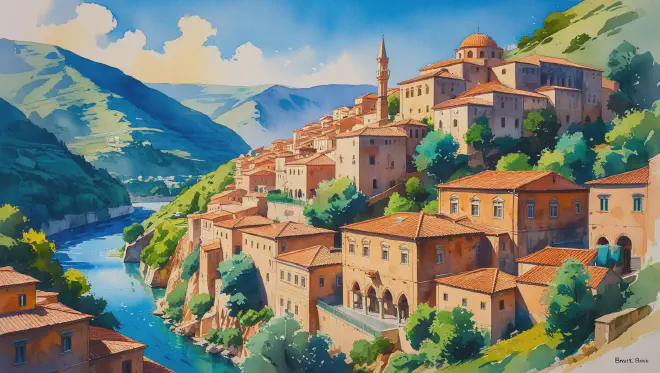Introduction: Berat, the White City Blooming on the Hill
Nestled in central Albania, Berat is a stunning historic city where Ottoman architecture’s white walls embrace the hillside slopes. Known as the “City of a Thousand Windows,” this place is also inscribed on UNESCO’s World Heritage List. The Ottoman-era houses line the riverbank in orderly rows, and when viewed from across the water, they create a landscape that appears as if countless eyes have opened upon the hillside.
The city of Berat is divided into the Mangalem and Gorica quarters, separated by the Osum River, connected by a stone bridge. The scenery of red-roofed, white-walled houses, narrow cobblestone alleys, and quiet Orthodox churches coexisting with minaret-topped mosques silently narrates the complex history of the Balkans.
The sky stretches wide, the river water runs crystal clear, and beyond the town, rolling hills continue like waves. The bustle of tourism remains modest here, and there’s a gentle silence about this place, as if time has somehow paused.
It was to such a Berat that I found myself drawn.

Day 1: Arrival, Afternoon Rain, and Evening Tranquility
After a two-and-a-half-hour bus ride from Tirana International Airport, with wheat fields and olive groves stretching past the windows, the bus arrived at Berat’s terminal at 1 PM. A light rain was falling.
My accommodation was a guesthouse in the middle slopes of Mangalem quarter—a small house converted from Ottoman-style architecture. Ana, the owner, welcomed me with a gentle smile and led me to a room surrounded by stone stairs and handcrafted wooden furniture. From the window, I could see the entire Gorica quarter, its red roofs glistening softly in the rain.
I spent the afternoon walking through town with an umbrella. Mangalem’s narrow slopes were slippery, and while carefully watching my footing, I happened upon a small café where I ordered an espresso with milk. The elderly proprietor, unable to communicate with me in words, smiled warmly and handed me an Albanian newspaper. Though I couldn’t understand the meaning, his gesture warmed my heart.
When the rain stopped at dusk, I crossed the Gorica Bridge to the opposite bank. The view of Berat from atop the stone bridge was like a scene from a painting. The evening sun painted the white walls orange, and a faint rainbow arced across the sky.
For dinner, I chose a local restaurant near my guesthouse. I ordered byrek (pie) topped with sheep’s cheese, a salad of tomatoes and cucumbers, and tavë (stew) with chicken and vegetables. The food was simple yet deeply nourishing, satisfying me from the core.
That night, I sat alone on the guesthouse terrace with a glass of wine. The red wine that Ana had described as “made from our family vineyard” was fruity and smooth. The town’s lights danced on the river’s surface, and a gentle breeze caressed my cheek. Until sleep took me, I surrendered myself to that quietude.
Day 2: The Hilltop Castle and Icon Prayers, Roads in the Wind
Morning arrived wrapped in crisp air. The guesthouse breakfast consisted of fresh-baked bread, homemade honey, yogurt with fig jam. After draining the strong coffee Ana had brewed, I set out walking toward Berat Castle atop the hill.
The path to the castle was steep, but flowers bloomed along both sides of the cobblestone way, and old houses lined the route. Children called out “Hello!” as I passed. Encouraged by their innocent smiles, I climbed the slope until my view opened up to reveal the entire town and distant mountains.
Berat Castle holds ancient history, containing several churches and residential ruins within its walls. At the Church of Saint Mary, I stopped by the Onufri Icon Museum. The space, lined with golden and vermillion icons, was filled with silence, as if the time of prayer still breathed there.
For lunch, I visited a small restaurant near the castle, enjoying grilled eggplant with mint yogurt, lamb skewers with rice pilaf. The cherry juice recommended with a smile by a local woman was refreshingly crisp.
In the afternoon, I returned to town and strolled leisurely along the riverside promenade. I paused at a souvenir shop and bought a small ceramic plate. Its pattern depicted Berat’s townscape. The shopkeeper carefully wrapped it and said in English, “Please come again.”
As day turned to evening, I headed back to Gorica quarter. This time I climbed Gorica Hill to gaze across the river at Berat. The contrast of light and shadow was beautiful, and an emotion filled my chest that words could never adequately express.
Dinner was at a small bistro in the town center. I slowly savored truffle risotto and herb-seasoned lamb. Chatting briefly with the server, I learned he was a student who dreamed of opening his own café someday. That dream felt as soft and warm as the air of this town.
That night, I returned to my room and recorded the day’s events in a small diary. As I dimmed the lights and closed my eyes in the quiet darkness, I felt my heart expanding endlessly along with the sound of the wind.
Day 3: Morning Market and Farewell Landscape
On my final day, I woke early and headed to the town market. At the square down the slopes of Mangalem, vegetables, fruits, cheeses, and herbs were laid out, overflowing with the vitality of local people. I bought dried figs in a small basket and lavender packed in a cloth bag as travel mementos.
Returning to the guesthouse, Ana smiled and said, “Come back anytime.” Those words touched my heart deeply.
As the bus swayed along, I gazed out the window at Berat growing distant. The white-walled houses seemed to wave quietly in farewell.
The end of a journey always brings a touch of loneliness and, even more, a quiet satisfaction. Though my time in Berat was brief, its air, scents, and sounds were certainly etched within me.
Finally: What Felt Real Despite Being Imaginary
This journey was not real—it was woven within imagination. Yet the tranquility of Berat as a place, the kindness of the people living there, and the experience of dissolving into the landscape felt vividly real and warm, almost indistinguishable from reality.
Perhaps it was precisely because this was imagination that I could travel, touch, and feel with complete freedom of heart. But every breeze, fragrance, and scene that existed there breathes with certainty within my heart.
This is a journey that, despite being imaginary, feels as though it truly happened.

